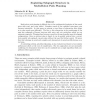55 search results - page 3 / 11 » Exploiting similarities for robot perception |
JAIR
2008
13 years 5 months ago
2008
Multi-robot path planning is difficult due to the combinatorial explosion of the search space with every new robot added. Complete search of the combined state-space soon intracta...
ICRA
2010
IEEE
13 years 3 months ago
2010
IEEE
— The latency of a perception system is crucial for a robot performing interactive tasks in dynamic human environments. We present MOPED, a fast and scalable perception system fo...
AAAI
2000
13 years 6 months ago
2000
Self-localisation is an essential competence for mobile robot navigation. Due to the fundamental unreliability of dead reckoning, a robot must depend on its perception of external...
ICRA
2000
IEEE
13 years 9 months ago
2000
IEEE
The formulation and optimization of joint trajectories for humanoid robots is quite different from this same task for standard robots because of the complexity of the humanoid rob...
FGR
2008
IEEE
13 years 6 months ago
2008
IEEE
Traditional discriminate analysis treats all the involved classes equally in the computation of the between-class scatter matrix. However, we find that for many vision tasks, the...

